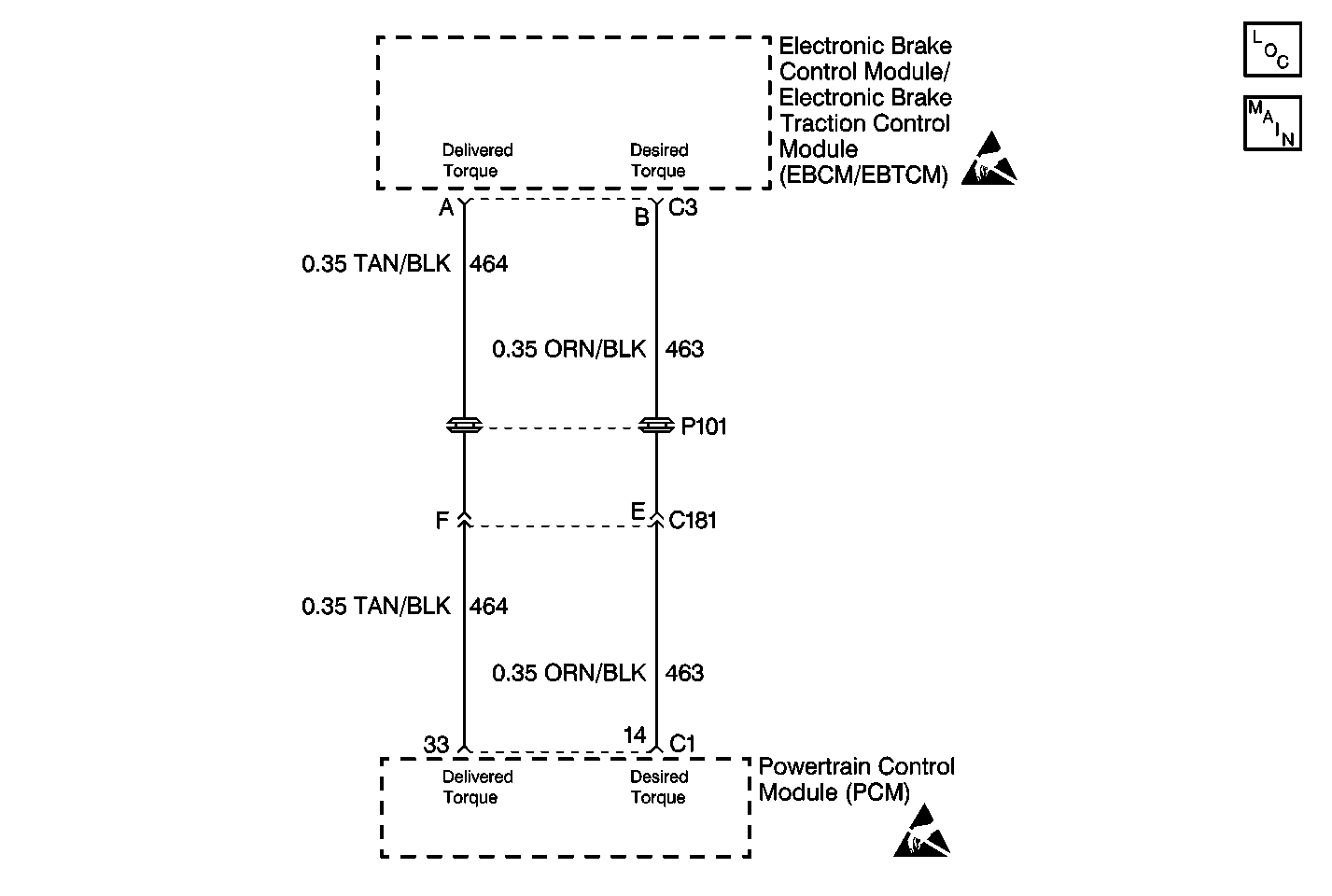
Circuit Description
The traction control system uses the antilock brake system in conjunction with the PCM fuel and ignition controls to limit drive wheel slippage during acceleration. The PCM controlled portion of the traction control system reduces engine torque by performing one or both of the following actions:
| • | Retarding the spark timing and alternating the air/fuel ratio |
| • | Shutting off up to three injectors |
The EBCM/EBTCM sends a torque request to the PCM via a Pulse Width Modulated (PWM) signal requesting the desired torque level for proper traction control system operation (CKT 463). The PCM then provides a delivered torque PWM signal (CKT 464) informing the EBCM/EBTCM how much actual torque the engine produces.
Conditions for Setting the DTC
DTC C1324 will set when one of the following conditions occurs:
| • | A malfunction exists in the delivered torque circuit (CKT 463). |
| • | The signal is out of range. |
Action Taken When the DTC Sets
| • | A malfunction DTC stores. |
| • | The ETS/TCS disables. |
| • | The amber TCS indicator turns on. |
Conditions for Clearing the DTC
| • | The condition responsible for setting the DTC no longer exists and the Scan Tool Clear DTCs function is used. |
| • | 100 drive cycles pass with no DTC(s) detected. |
Diagnostic Aids
The following conditions may cause an intermittent malfunction:
| • | A poor connection |
| • | Rubbed-through wire insulation |
| • | A broken wire inside the insulation |
Use the enhanced diagnostic function of the Scan Tool in order to measure the frequency of the malfunction. Refer to the scan tool manual for the procedure.
Thoroughly inspect any circuitry that may cause the intermittent complaint for the following conditions:
| • | Backed out terminals |
| • | Improper mating |
| • | Broken locks |
| • | Improperly formed or damaged terminals |
| • | Poor terminal-to-wiring connections |
| • | Physical damage to the wiring harness |
Step | Action | Value(s) | Yes | No | ||||||||||||
|---|---|---|---|---|---|---|---|---|---|---|---|---|---|---|---|---|
1 | Was the Diagnostic System Check performed? | -- | Go to Diagnostic System Check | |||||||||||||
2 | Inspect the following grounds in order to verify that each ground is clean and torqued to the proper specifications:
Are any of the grounds loose, damaged, or corroded? | -- | ||||||||||||||
3 |
Do not start the engine. Is the voltage equal to or greater than the specified voltage? | 4.5-5.5 V | ||||||||||||||
4 | Use the J 39200 in order to measure the voltage between the 8-way EBCM/EBTCM harness connector terminal B and ground. Is the voltage equal to or greater than the specified voltage? | 10.0 V | ||||||||||||||
5 |
Do not start the engine. Is the voltage within the specified voltage? | 0.0-2.0 V | ||||||||||||||
6 |
Are poor terminal contact, terminal corrosion, or terminal damage present? | -- | ||||||||||||||
7 |
Is the resistance within the specified range? | 0.0-2.0 ohms | ||||||||||||||
8 | Use the J 39200 in order to measure the resistance between the following components the 8-way EBCM/EBTCM harness connector terminal B and ground. Is the resistance within the specified range? | OL (Infinite) | ||||||||||||||
9 |
Do any of the terminals exhibit poor terminal contact or corrosion, or damage? | -- | ||||||||||||||
10 |
Do not start the engine. Does DTC C1324 reset? | -- | ||||||||||||||
11 |
Do not start the engine Does DTC C1324 reset? | -- | ||||||||||||||
12 | Repair the short to voltage in CKT 463. Is the repair complete? | -- | Go to Diagnostic System Check | -- | ||||||||||||
13 | Repair the open or the high resistance in CKT 463. Is the repair complete? | -- | Go to Diagnostic System Check | -- | ||||||||||||
14 | Repair the short to ground in CKT 463. Is the repair complete? | -- | Go to Diagnostic System Check | -- | ||||||||||||
15 | Replace all the terminals or the connectors that exhibit the following conditions:
Is the repair complete? | -- | Go to Diagnostic System Check | -- | ||||||||||||
16 | Inspect the PCM. Go to Engine Controls. Is the diagnosis complete? | -- | Go to Diagnostic System Check | -- | ||||||||||||
17 | Replace the EBCM/EBTCM. Is the repair complete? | -- | Go to Diagnostic System Check | -- | ||||||||||||
18 | Repair the ground as necessary. Refer to Repair Procedures Cell 5 in Electrical Diagnosis. Is the repair complete? | -- | Go to Diagnostic System Check | -- | ||||||||||||
19 | The malfunction is intermittent or is not present at this time. Is the repair complete? | -- | Go to Diagnostic Aids | -- |
